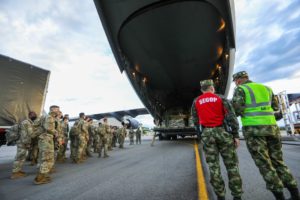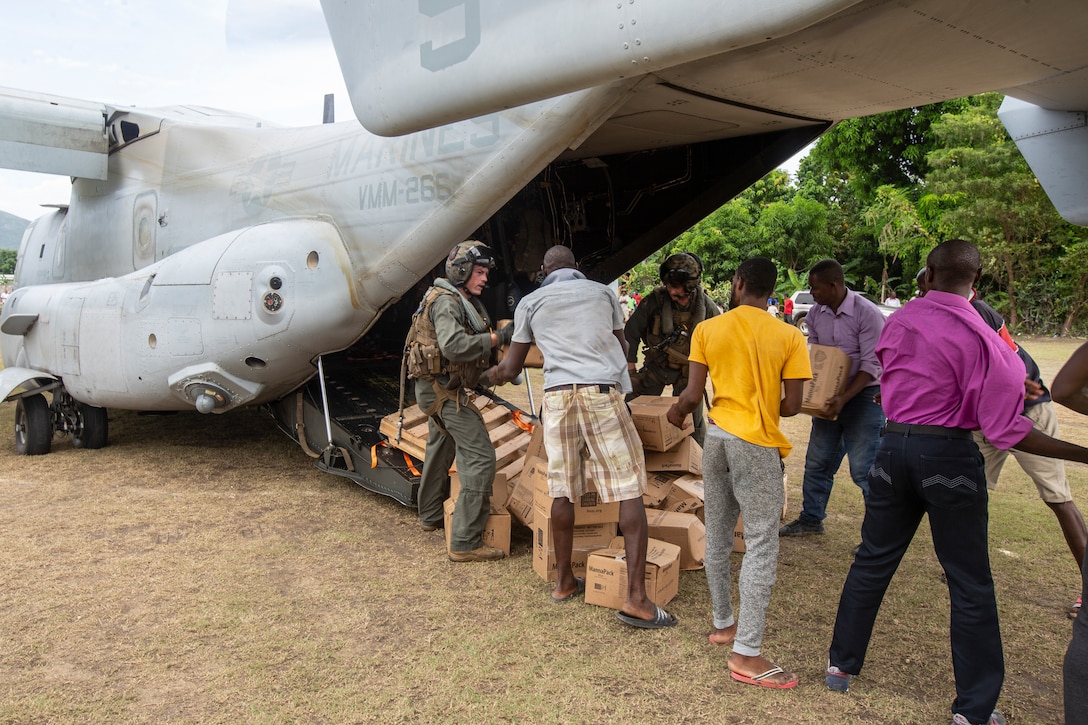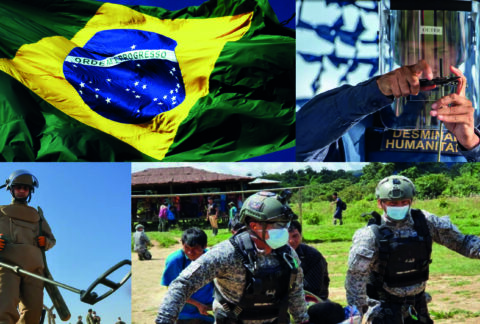How SOUTHCOM is Re-Shaping Intelligence Security Cooperation in the AOR through Collaboration Warfare
“We’re connected to the nations in Latin America and [the] Caribbean by history, culture, and geography. We’re connected in every domain, sea, air, space, and cyber and land. Our security and prosperity are inextricably linked. When our neighbors succeed, we succeed, and when our neighbors are threatened, we are threatened. Our partnerships in this region are critical to the layered defense of our homeland and to our collective ability to meet complex global challenges.”
Admiral Craig Faller, commander, SOUTHCOM
Testimony to Senate Armed Forces Committee, 77,
February 2019
U.S. Southern Command (SOUTHCOM) is unlike any other Combatant Command in the world. While its charter is to prepare for full-spectrum military operations from threats within its Area of Responsibility (AOR), its day-to-day mission is maintaining the peace through security cooperation with domestic and international partners.
This AOR shares numerous common interests with the U.S. and building relationships is important. As Jeffrey Marshall states in “Skin in the Game” in any partnership, building partner nation intelligence capabilities is a team sport — relationships matter; they must be built, sustained, and nourished or they will not work. Therefore, gaining and maintaining access with willing and able partners in our AOR is paramount to maintaining security in the area of responsibility.
Over the past three years, USSOUTHCOM J2 intelligence professionals have taken Intelligence Security Cooperation (ISC) to a new level by collectively working by, with, and through our partners to improve intelligence cooperation in Latin America and the Caribbean to counter threats — we call it “Collaboration Warfare.”
Collaboration Warfare includes all the theater security cooperation intelligence activities SOUTHCOM conducts with friends, allies, and partners to build relationships, increase partner nation capabilities for self-defense, conduct coalition operations, promote specific U.S. interests, and provide U.S. forces with peacetime and contingency access. This also includes “threat information fusion” through the expansion of collaboration and threat information sharing in targeted intelligence activities to include working on joint-combined intelligence products with our partners.
Some of the threats we face in the SOUTHCOM operational environment areU.S. Air Force Colonel Pedro Matos and Mr. Edward Daes U.S. Air Force Colonel Pedro Matos and Mr. Edward Daes[:
- Poverty — Over 61 million people live in extreme poverty and 220 million people live on less than $10 a day in this region. As of 2020, the economic crisis in Venezuela led to devastating food shortage and starvation. The United Nations Organization for Food and Agriculture estimates that more than 42 million people in South America are suffering from hunger.
- Environmental Fragility — Many nations in the region are natural disaster prone. Deforestation, illegal mining, and climate change continue to erode the environment.
- Shifting Political Scene — Uneven democratic consolidation depresses democracy in the region.
- Threat networks — Transnational Criminal networks, narcotic traffickers, human smugglers, weapons traffickers, and violent extremist organizations operate with impunity.
- External State Actors (ESAs) — ESAs are expanding influence in the region. This is eroding relationships with the U.S. and its partners, challenging U.S. leadership.
Moreover, more traditional threats such as transnational organized crime, illicit trafficking, urban gangs, narco-terrorism, violent extremist organizations, natural disasters, and mass migration make attaining security and prosperity a difficult challenge.
Besides building stronger relationships, using Collaboration Warfare U.S. and partner nation forces, SOUTHCOM J2 has attained a great deal of incidental and shared information during Intelligence Conferences and seminars. From the intelligence sharing perspective, SOUTHCOM Directorate of Intelligence hosts two major Regional Intelligence Conferences annually and assist with the planning of a third. They are:
- The Caribbean Regional Intelligence Conference (CARIC)
- Central America Regional Intelligence Conference (CRIC)
- The South American Strategic Intelligence Conference (SIC)
Much of the environmental information required for preparing the combatant commander’s strategic estimate is gained by interaction with partner nations personnel at these conferences. Through personal interaction with partner militaries, all partner nations can glean specific kinds of intelligence and be more in tune to cues of growing security threats they were not previously aware of.

But conferences in-and-of-themselves are not the panacea to our shared threats in the region. Over the last three years, our ISC efforts have evolved from co-hosting once a year trust building conferences with our partners in the region, to results driven intelligence enterprise. By empowering and enabling each of our partners in the region to practice and implement open-source (OSINT) threat intelligence fusion, we are developing interoperability with our trusted and most valuable partners in the SOUTHCOM AOR.
We started down this path by developing the first Caribbean and Central American threat network matrix project, which resulted in the identification of over 64 threat networks across the Caribbean and Central America — all catalogued into a shared combined All Partners Nations Network (APAN). Second, we developed Priority Intelligence Requirements for the Caribbean and a 333 Program in Central America for Guatemala resulting in building an Intelligence Doctrine and Intelligence Corps. Third, we introduced the use of a collection management plan to focus collection at the partner nation level. And fourth, we introduced the use of the all-partner nation network (APAN) and ARCGIS a geo spatial mapping tool that maintains threat data and visually depicts the threat networks in the region. By doing this, we will all be able — for the first time — to visually and holistically see locations of threat networks and potentially develop targeting strategies. This established a common Caribbean platform for collaboration.
Another initiative we have undertaken is the Academic Enhanced Domain Awareness (EDA) project in collaboration with Florida International University’s (FIU) Associate Director for Research Innovation. This was born out of the fact that there is no existing centralized and secure platform that can bring numerous contributors (nations, international organizations) to share, collaborate, and learn as we work together to solve security issues. Therefore, we envisioned a project which involves hundreds of organizations separately that collect, analyze, and process data of threats in the AOR. SOUTHCOM has invested significantly in developing an extensive network of virtual collaboration platforms with partner nation military intelligence representatives. Members will be able to contribute and withdraw raw data in a central repository. The digital infrastructure allows communities of interest to analyze and collaborate with raw streams of open source information, as well as tools to create products. Together we will be able to analyze greater volumes of raw data and collaborate on issues of common interest. Countering threats in the AOR takes a team effort and with this platform we can be more effective.
The COVID-19 pandemic affected the way that we conduct security cooperation activities. However, we viewed the pandemic not as an obstacle to ISC but as an opportunity. Although face-to-face is the preferred method of engaging with our foreign partners, we were able to adjust all our engagements to a virtual format. This not only saved us travel funds, but it gave us and our partners a strategic advantage to hold even more events virtually. Three years ago, we engaged in approximately 10 face-to-face ICS events. Now we are executing over 30 virtual ISC events per year, tripling our touchpoints with the same number of personnel. In essence, we took advantage of the COVID-19 pandemic and used the digital platform to create a solid return on investment.
This past year we also pushed for an increase in virtual working groups, Key Leader Engagements, Subject Matter Expert Exchanges (SMEEs), and Seminars through the use of numerous virtual platforms. During these virtual events we refined and completed several intelligence products which gave us a more refined and holistic Common Intelligence Picture of the threat environment in our AOR. This effort resulted in the first ever combined Threat Intelligence Product at the Action Officer level, which will serve as a decision support aid for all our leaders.
COVID-19 not only impacted our face-to-face engagements with partner nations but it al resulted in the cancellation of all our International Intelligence Security Cooperation Conferences. However, we moved quickly to resolve this conflict and executed them in a virtual setting. Our intelligence conferences are designed to operationalize intelligence of our partners in the region. Through the Intelligence Conferences we collectively collaborate with our international partners and organizations and develop intelligence efforts to enable informed decision making.
For example, many of our CARIC and CRIC partners developed Humanitarian Assistance/Disaster Relief (HA/DR) Priority Intelligence Requirements to operationalize and deconflict the ability of regional organizations to counter threats and enhance partnerships. These partnerships resulted in cooperative relationships and the expansion of threat information sharing and fusion through increased intelligence seminar and SMEEs in the AOR.
Most recently, during the Haiti Earthquake (August 2021), SCJ29 pushed Collaboration Warfare and Information Fusion with our allied partners from the United Kingdom, France, Canada, and the Netherlands to coordinate with appropriate SOUTHCOM entities in support of Haiti Relief Efforts to include, directly linking allies and their frigates operating in the AOR to the daily SOUTHCOM Mission Update Brief (MUB), Joint Collection Management Branch (JCMB), the Intelligence Fusion Cell (IFC), as well as the Haiti Community of Interest (COI). We were also able to leverage the French, Netherlands, United Kingdom to conduct ISR in support of SOUTHCOM RFIs and HA/DR Haiti products to include piers, overhead damage assessments, various infrastructure assessments (bridges, roads), and possible Hot Landing Zones in order to provide relief to the people of Haiti.
Furthermore, due to our partnering efforts with the Caribbean we were able to leverage the Caribbean Disaster Emergency Management Agency (CDEMA) located in Bridgetown, Barbados, with the SOUTHCOM HAITI IFC. CDEMA and their component called the Multi-National Caribbean Coordination Cell (MNCCC) connected with the SOUTHCOM HAITI IFC. The MNCCC is a civil-military group that seeks to synchronize and deconflict Air/Maritime/Ground assets and acts as an information clearing house on the international response effort. CDEMA and the MNCCC are sharing information with respect to the disaster relief efforts to ensure deconfliction and reduce overlap. This connection resulted in numerous valuable RFIs being answered by the community for better situational awareness in Haiti Relief Efforts.
Our hemisphere suffers from debilitating social conditions, which challenge governments and society; weak governance, corruption, poverty, unequal wealth distribution, social class exclusion, impunity, porous borders, and underemployment have a destabilizing influence in our AOR.
Building a mutually supportive intelligence enterprise with our partners is beneficial for several reasons:
- The enterprise can support specified U.S. interests
- It builds allied and friendly nation capabilities for self-defense and coalition operations
- It provides U.S. forces with peacetime and contingency access
- It creates mutual benefits for all partner nations working together
- Nations can leverage strengths from other partner nations
- It builds a common intelligence picture and security network
- It provides capacity-building for intelligence services
- It creates responsible intelligence organizations free of corruption.
As with all endeavors, SOUTHCOM Intelligence Directorate Engagement Program requires a network. Spearheading this initiative is the US BICES-X SOUTH UNCLASSIFIED Multi-Lateral Network Team. SOUTHCOM is the sole Component Command with a US BICES-X SOUTH UNCLASSIFIED Multi-Lateral Network. Currently, this network supports two regional Intelligence Communities of Interest for South America (SURNET) and Central America (REDICA). Due to its success, SOUTHCOM will extend the network to the Caribbean (CARIC) in the near future. Eight partner nations from South America are currently members of SURNET and six partner nations are active members of the REDICA network. Nicaragua has recently shown interest in being added to REDICA.
However, all the systems in the world cannot be effective alone. We cannot build partner nation capacity unless we build trust with our partner nations. Unfortunately, trust cannot be “surged” when you need it most — like during a crisis. Trust has to be built over time, patiently, on solid and mature relationships, shared values, mutual interests and respect for one another. Some of the challenges faced in building trust are historical differences, different cultures, geopolitical interests, different languages, and differences of opinion.
As we build trust and relationships in our AOR, understanding the human terrain of another culture is critical and there is no substitute for face-to-face interaction, particularly in Latin America and the Caribbean. Knowledge and understanding occur through interaction, whether in person or virtual, or through reading and assimilating materials.
Intelligence Engagement activities and a robust capability based on persistent engagement have played an essential role in helping the SOUTHCOM commander better understand the human and physical environment of our AOR. SOUTHCOM’s persistent engagement in Latin America is showing significant results beyond the Colombian military’s internal security operations against the Revolutionary Armed Forces of Colombia (FARC, in Spanish); Colombia now has a very capable military that serves as a regional check against external threats and is exporting stability and security throughout the AOR through its heavy engagements presence.
If war is the violent resolution of conflict, then intelligence cooperation and engagement is the ability to resolve conflict without violence. By the time we have a crisis (which requires immediate action) it’s likely too late to begin building relationships or engage with the partner nations.
We are meeting this need by seeking to be the security partner of choice with Latin American and Caribbean partner nations while at the same time developing innovative, low-cost, and small-footprint approaches to achieve security objectives in our AOR.
We have synergized innovation and demonstrated that together we can set the conditions to effect, deny, and disrupt our common threats with our partners, and maintain intelligence partners that are interoperable with U.S. and other coalition members, willing and capable of providing predictive, actionable intelligence and information in support of prosperity, stability, and security in the hemisphere.
About the Authors
U.S. Air Force Colonel Pedro Matos is the Military Deputy Director of Intelligence and Chief of Intelligence Security Cooperation Division at U.S. Southern Command Directorate of Intelligence (J2).
Mr. Edward Daes is a Senior Intelligence Officer at SCJ29, U.S. Southern Command Directorate of Intelligence (J2).
Disclaimer: The views and opinions expressed in this article are those of the author. They do not necessarily reflect the official policy or position of any agency of the U.S. government, Diálogo magazine, or its members.









